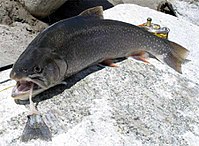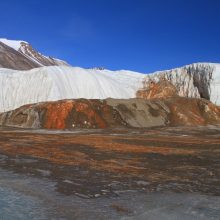
Recruitment of benthic invertebrates in high Arctic fjords: Relation to temperature, depth, and season
Sign Up to like & getrecommendations! Published in 2017 at "Limnology and Oceanography"
DOI: 10.1002/lno.10602
Abstract: In the high Arctic, recruitment of hard-bottom benthic organisms has been studied at single locations, but little is known about how it varies spatially or temporally, or how it is influenced by abiotic factors. In… read more here.
Keywords: benthic invertebrates; recruitment; invertebrates high; high arctic ... See more keywords

Methane cold seeps as biological oases in the high‐Arctic deep sea
Sign Up to like & getrecommendations! Published in 2018 at "Limnology and Oceanography"
DOI: 10.1002/lno.10732
Abstract: Cold seeps can support unique faunal communities via chemosynthetic interactions fueled by seabed emissions of hydrocarbons. Additionally, cold seeps can enhance habitat complexity at the deep seafloor through the accretion of methane derived authigenic carbonates… read more here.
Keywords: deep sea; high arctic; methane; cold seeps ... See more keywords

A spatial model for return values of warm extremes in the high Arctic
Sign Up to like & getrecommendations! Published in 2020 at "Quarterly Journal of the Royal Meteorological Society"
DOI: 10.1002/qj.3877
Abstract: Wintertime warm extremes in the high Arctic, primarily associated with intrusions of moist airmasses from the midlatitudes, have occurred with an ostensibly high frequency in recent years. Here, we compute the temperature anomaly return values… read more here.
Keywords: spatial model; warm extremes; return; high arctic ... See more keywords

Microbial Organic Matter Utilization in High-Arctic Streams: Key Enzymatic Controls
Sign Up to like & getrecommendations! Published in 2019 at "Microbial Ecology"
DOI: 10.1007/s00248-019-01330-w
Abstract: In the Arctic, climate changes contribute to enhanced mobilization of organic matter in streams. Microbial extracellular enzymes are important mediators of stream organic matter processing, but limited information is available on enzyme processes in this… read more here.
Keywords: matter; high arctic; arctic streams; matter utilization ... See more keywords

Muskoxen Modify Plant Abundance, Phenology, and Nitrogen Dynamics in a High Arctic Fen
Sign Up to like & getrecommendations! Published in 2018 at "Ecosystems"
DOI: 10.1007/s10021-018-0323-4
Abstract: Herbivores are key drivers of vegetation dynamics in most ecosystems. However, the effect of high arctic herbivores on vegetation dynamics throughout a growing season is not well understood. In this study, we examine the impacts… read more here.
Keywords: nitrogen; plant; muskoxen; biomass ... See more keywords

High Arctic Vegetation Change Mediated by Hydrological Conditions
Sign Up to like & getrecommendations! Published in 2020 at "Ecosystems"
DOI: 10.1007/s10021-020-00506-7
Abstract: Increasing air temperatures are driving widespread changes to Arctic vegetation. In the high Arctic, these changes are patchy and the causes of heterogeneity are not well understood. In this study, we explore the determinants of… read more here.
Keywords: productivity; high arctic; vegetation; vegetation change ... See more keywords

Nitrogen fixation in the High Arctic: a source of ‘new’ nitrogen?
Sign Up to like & getrecommendations! Published in 2017 at "Biogeochemistry"
DOI: 10.1007/s10533-017-0393-y
Abstract: Biological nitrogen (N2) fixation performed by diazotrophs (N2 fixing bacteria) is thought to be one of the main sources of plant available N in pristine ecosystems like arctic tundra. However, direct evidence of a transfer… read more here.
Keywords: nitrogen; nitrogen fixation; fixation; source ... See more keywords

Exploring the role of High Arctic Large Igneous Province volcanism on Early Cretaceous Arctic forests
Sign Up to like & getrecommendations! Published in 2021 at "Cretaceous Research"
DOI: 10.1016/j.cretres.2021.105022
Abstract: Abstract The Hauterivian–Aptian aged Isachsen Formation at Glacier Fiord, Axel Heiberg Island, in the Sverdrup Basin of the Canadian Arctic Archipelago was deposited contemporaneous with initiation of the High Arctic Large Igneous Province (HALIP). New… read more here.
Keywords: early cretaceous; arctic large; high arctic; igneous province ... See more keywords

Do high Arctic coastal food webs rely on a terrestrial carbon subsidy
Sign Up to like & getrecommendations! Published in 2018 at "Food Webs"
DOI: 10.1016/j.fooweb.2018.e00081
Abstract: Abstract Lagoons are a prominent feature of Arctic coastlines, support diverse benthic food webs, and provide vital feeding grounds for fish, migratory birds, and marine mammals. Across the Arctic, loading of terrestrial/freshwater-derived organic carbon (CT)… read more here.
Keywords: carbon; food webs; high arctic; subsidy ... See more keywords

The variability and controls of rock strength along rocky coasts of central Spitsbergen, High Arctic
Sign Up to like & getrecommendations! Published in 2017 at "Geomorphology"
DOI: 10.1016/j.geomorph.2016.06.014
Abstract: Abstract This paper presents the results of the Schmidt Hammer Rock Tests (SHRTs) across a range of rocky coastal landforms. Northern Billefjorden (central Spitsbergen), represents typical High Arctic microtidal fjord environment. Sheltered location and prolonged… read more here.
Keywords: central spitsbergen; strength; rock strength; high arctic ... See more keywords

Linkages between geochemistry and microbiology in a proglacial terrain in the High Arctic
Sign Up to like & getrecommendations! Published in 2018 at "Annals of Glaciology"
DOI: 10.1017/aog.2019.1
Abstract: ABSTRACT Proglacial environments are ideal for studying the development of soils through the changes of rocks exposed by glacier retreat to weathering and microbial processes. Carbon (C) and nitrogen (N) contents as well as soil… read more here.
Keywords: proglacial terrain; high arctic; geochemistry; microbiology ... See more keywords